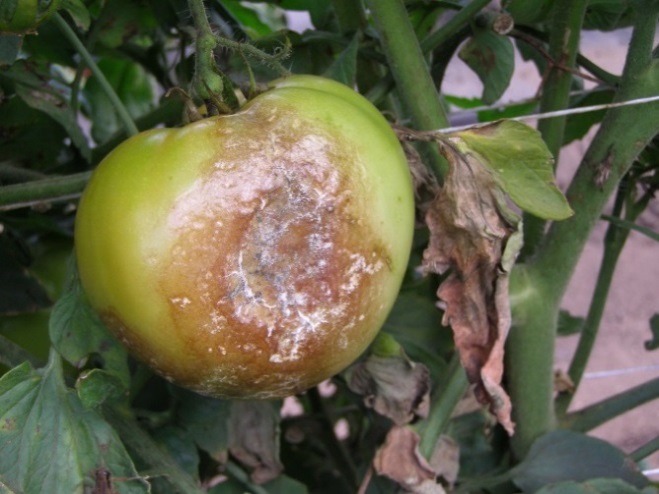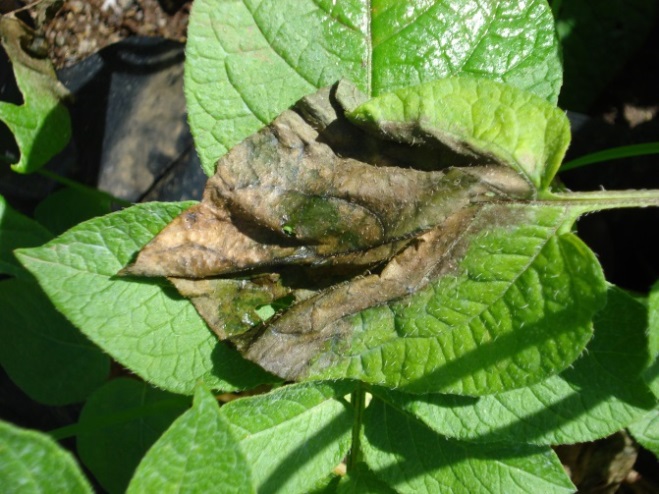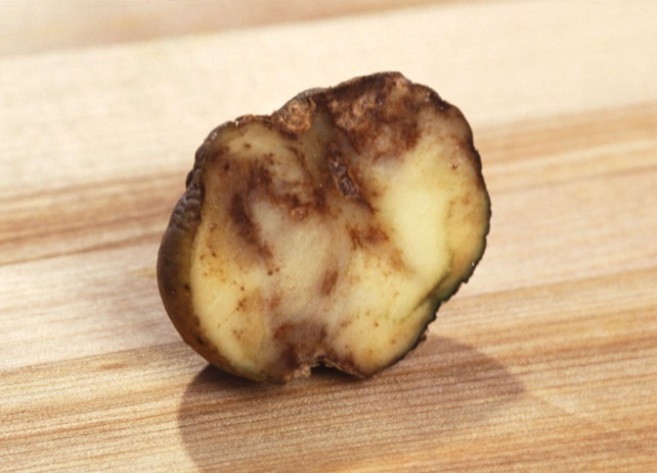
Late blight
| Primefact number | Edition | Published | Author |
|---|---|---|---|
| 1579 | First | Aug 2017 | Plant Biosecurity and Product Integrity |



Late blight (Phytophthora infestans) (A2 mating type) is an exotic plant disease not present in Australia. This disease is a serious threat to Australia’s potato, vegetable and fruit industries.
Late blight (caused by Phytophthora infestans) is one of the world’s worst diseases (or blight) of potatoes. Late blight caused the 1840’s European, Irish and Highland potato famines and destroys 5% of world potato crops every year. It is also a serious disease of capsicums, chillies, eggplants, pepinos, tamarillos and tomatoes (Figure 1).
Notifiable status
Late blight (Phytophthora infestans) (A2 mating type) is not a notifiable plant disease in NSW.
However, if you suspect Late blight (Phytophthora infestans) (A2 mating type):
- Call the Exotic Plant Pest Hotline 1800 084 881
- Email biosecurity@dpi.nsw.gov.au with a clear photo and your contact details
A full list of notifiable plant pests and diseases can be found in Schedule 2 of the NSW Biosecurity Act 2015.
Description
Late blight is caused by the water mould Phytophthora infestans. Though water moulds (or oomycetes) look similar to fungi, they are more closely related to algae. As a consequence late blight spores require water to germinate and penetrate host plant tissues.
Early signs of late blight infection are small flecks on infected leaves and plant stems. These grow into larger lesions. Infected tissue is initially water soaked (grey-green), then necrotic (brown or black) with firm, rough surfaces (Figure 2). Lesions are often enclosed by a halo of lighter green tissue. In humid weather white mould (or “fuzz”) grows under the leaves and infected plants suddenly collapse.
Infected potato tubers have brown to purple skin lesions that are dark, reddish brown underneath (Figure 3). They have an uneven, corky, dry rot inside and can become a foul-smelling mush if infected by secondary bacterial soft rots.
Damage
Late blight causes sudden plant death and destroys infected potato crops in a matter of days. It attacks the host plant’s foliage, fruit, stems or tubers at all growth stages. Healthy looking potato tubers may also break down in storage due to late blight infection.
Lifecycle
The Phytophthora infestans lifecycle alternates between mould growth and spore production. The asexual spore stage produces millions of thin-walled spores called sporangia. Each sporangia creates 20-40 thin-walled spores named zoospores. The sexual spore stage occurs inside plant material between the A1 and A2 mating types of sporangia and produces thick-walled spores called oospores.
Sporangia and zoospores are short-lived spores in plant debris or soil. They are killed by frosts and hot weather. Sporangia inside potato tubers and oospores may live for many years. The late blight lifecycle is completed under ideal conditions in five days, if the air temperatures remain above 10°C and humidity is over 75% for two consecutive days.
Host range
The main host of Phytophthora infestans is potatoes (Solanum tuberosum). Other hosts are capsicums (Capsicum annuum), chillies (C. frutescens), eggplants (S. melongena), pepinos (S. muricatum), tamarillos (S. betaceum) and tomatoes (S. lycopersicum). Host weeds include the kangaroo apple (S. laciniatum) and black (S. nigrum) and woody nightshade (S. dulcamara).
Spread
Late blight sporangia are spread between host plants by water or wind. Sporangia inside potato tubers can also disperse spores between crops. Infected tubers in crop debris, grading cull piles, seed potatoes and self-sown volunteer plants may spread sporangia.
Zoospores are washed by rain into the soil where they may infect young potato tubers. The thick-walled oospores travel longer distances by water or wind. Animals, humans and farm machinery can also carry late blight spores in infected plant material, soil or water on their hooves, footwear or tyres.
Distribution
Late blight Phytophthora infestans (A1 mating type) is distributed around the world. It is found in Asia, Africa, the Americas, Europe and Australia. Until the 1970’s late blight Phytophthora infestans (A2 mating type) was restricted to Mexico. It has since been detected in Burundi, Canada, Colombia, Ecuador, western Europe, Japan, Korea, Rwanda and the United States.
Actions to minimise risks
Put in place biosecurity best practice actions to prevent entry, establishment and spread of pests and diseases:
- practice “Come clean, Go clean”
- ensure all staff and visitors are instructed in and adhere to your business management hygiene requirements
- source propagation material of a known high health status from reputable suppliers
- monitor your crop regularly
- keep records

